Xu Li
Britton Chance Center for Biomedical Photonics, Wuhan National Laboratory for Optoelectronics-Huazhong University of Science and Technology, China
LVD-GS: Gaussian Splatting SLAM for Dynamic Scenes via Hierarchical Explicit-Implicit Representation Collaboration Rendering
Oct 26, 2025Abstract:3D Gaussian Splatting SLAM has emerged as a widely used technique for high-fidelity mapping in spatial intelligence. However, existing methods often rely on a single representation scheme, which limits their performance in large-scale dynamic outdoor scenes and leads to cumulative pose errors and scale ambiguity. To address these challenges, we propose \textbf{LVD-GS}, a novel LiDAR-Visual 3D Gaussian Splatting SLAM system. Motivated by the human chain-of-thought process for information seeking, we introduce a hierarchical collaborative representation module that facilitates mutual reinforcement for mapping optimization, effectively mitigating scale drift and enhancing reconstruction robustness. Furthermore, to effectively eliminate the influence of dynamic objects, we propose a joint dynamic modeling module that generates fine-grained dynamic masks by fusing open-world segmentation with implicit residual constraints, guided by uncertainty estimates from DINO-Depth features. Extensive evaluations on KITTI, nuScenes, and self-collected datasets demonstrate that our approach achieves state-of-the-art performance compared to existing methods.
Text2Move: Text-to-moving sound generation via trajectory prediction and temporal alignment
Sep 26, 2025Abstract:Human auditory perception is shaped by moving sound sources in 3D space, yet prior work in generative sound modelling has largely been restricted to mono signals or static spatial audio. In this work, we introduce a framework for generating moving sounds given text prompts in a controllable fashion. To enable training, we construct a synthetic dataset that records moving sounds in binaural format, their spatial trajectories, and text captions about the sound event and spatial motion. Using this dataset, we train a text-to-trajectory prediction model that outputs the three-dimensional trajectory of a moving sound source given text prompts. To generate spatial audio, we first fine-tune a pre-trained text-to-audio generative model to output temporally aligned mono sound with the trajectory. The spatial audio is then simulated using the predicted temporally-aligned trajectory. Experimental evaluation demonstrates reasonable spatial understanding of the text-to-trajectory model. This approach could be easily integrated into existing text-to-audio generative workflow and extended to moving sound generation in other spatial audio formats.
Training-Free Pyramid Token Pruning for Efficient Large Vision-Language Models via Region, Token, and Instruction-Guided Importance
Sep 19, 2025Abstract:Large Vision-Language Models (LVLMs) have significantly advanced multimodal understanding but still struggle with efficiently processing high-resolution images. Recent approaches partition high-resolution images into multiple sub-images, dramatically increasing the number of visual tokens and causing exponential computational overhead during inference. To address these limitations, we propose a training-free token pruning strategy, Pyramid Token Pruning (PTP), that integrates bottom-up visual saliency at both region and token levels with top-down instruction-guided importance. Inspired by human visual attention mechanisms, PTP selectively retains more tokens from visually salient regions and further leverages textual instructions to pinpoint tokens most relevant to specific multimodal tasks. Extensive experiments across 13 diverse benchmarks demonstrate that our method substantially reduces computational overhead and inference latency with minimal performance loss.
HERO: Rethinking Visual Token Early Dropping in High-Resolution Large Vision-Language Models
Sep 16, 2025Abstract:By cropping high-resolution images into local tiles and encoding them independently, High-Resolution Large Vision-Language Models (HR-LVLMs) have demonstrated remarkable fine-grained visual understanding capabilities. However, this divide-and-conquer paradigm significantly increases the number of visual tokens, resulting in substantial computational and memory overhead. To better understand and address this challenge, we empirically investigate visual token utilization in HR-LVLMs and uncover three key findings: (1) the local tiles have varying importance, jointly determined by visual saliency and task relevance; (2) the CLS token in CLIP-based vision encoders exhibits a two-stage attention pattern across layers, with each stage attending to different types of visual tokens; (3) the visual tokens emphasized at different stages encode information at varying levels of granularity, playing complementary roles within LVLMs. Building on these insights, we propose HERO, a High-resolution visual token early dropping framework that integrates content-adaptive token budget allocation with function-aware token selection. By accurately estimating tile-level importance and selectively retaining visual tokens with complementary roles, HERO achieves superior efficiency-accuracy trade-offs across diverse benchmarks and model scales, all in a training-free manner. This study provides both empirical insights and practical solutions toward efficient inference in HR-LVLMs.
Joint decoding method for controllable contextual speech recognition based on Speech LLM
Aug 12, 2025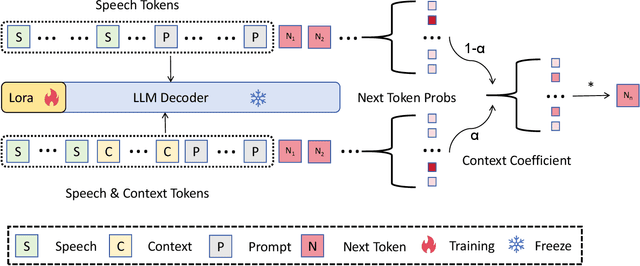
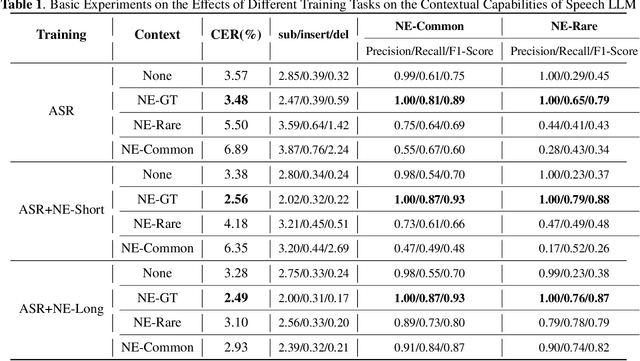
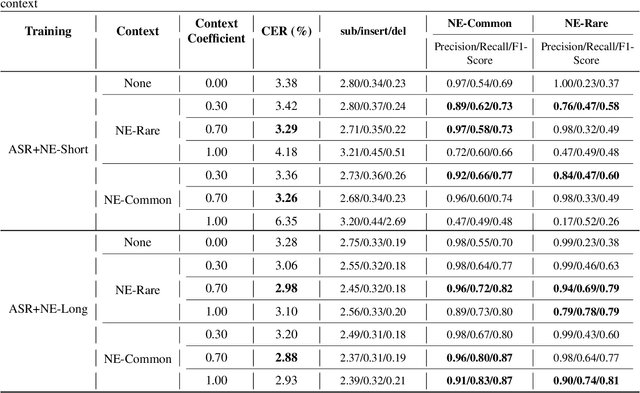
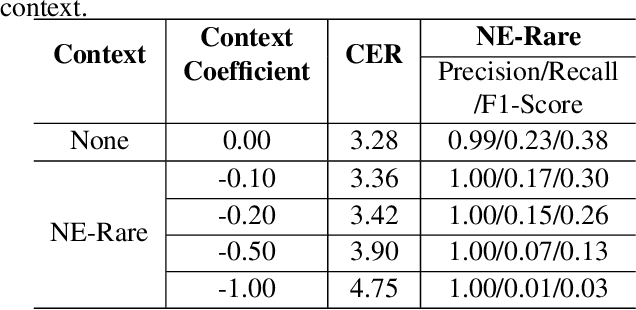
Abstract:Contextual speech recognition refers to the ability to identify preferences for specific content based on contextual information. Recently, leveraging the contextual understanding capabilities of Speech LLM to achieve contextual biasing by injecting contextual information through prompts have emerged as a research hotspot.However, the direct information injection method via prompts relies on the internal attention mechanism of the model, making it impossible to explicitly control the extent of information injection. To address this limitation, we propose a joint decoding method to control the contextual information. This approach enables explicit control over the injected contextual information and achieving superior recognition performance. Additionally, Our method can also be used for sensitive word suppression recognition.Furthermore, experimental results show that even Speech LLM not pre-trained on long contextual data can acquire long contextual capabilities through our method.
Large Language Models Enhanced by Plug and Play Syntactic Knowledge for Aspect-based Sentiment Analysis
Jun 15, 2025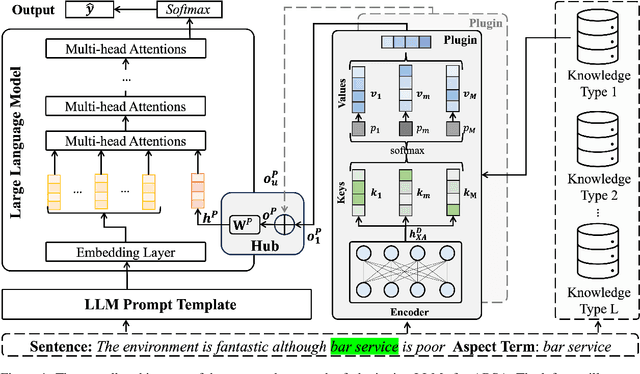
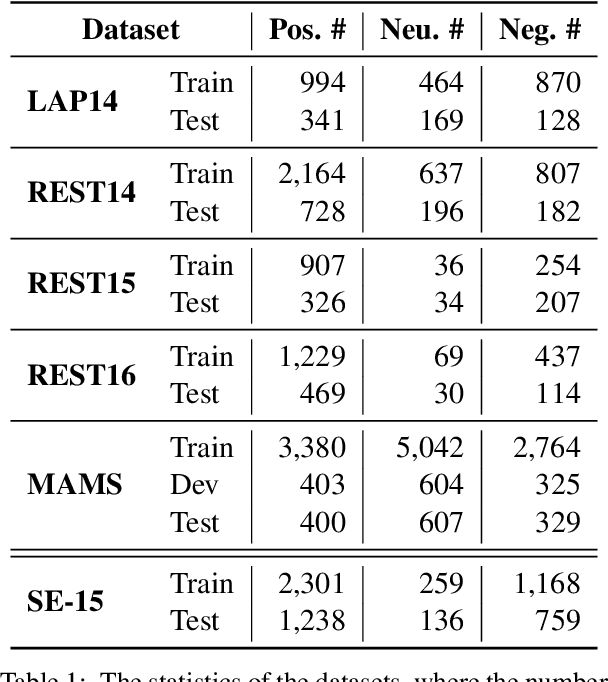

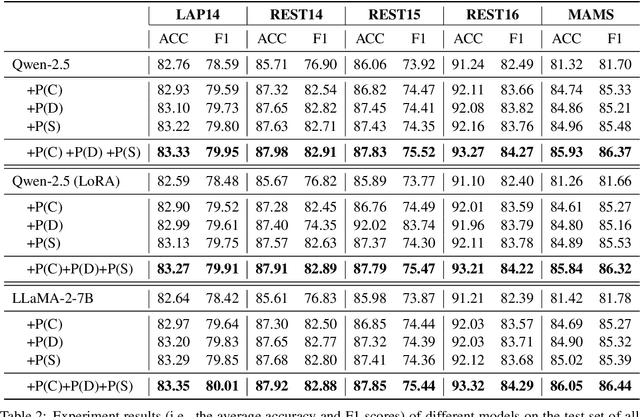
Abstract:Aspect-based sentiment analysis (ABSA) generally requires a deep understanding of the contextual information, including the words associated with the aspect terms and their syntactic dependencies. Most existing studies employ advanced encoders (e.g., pre-trained models) to capture such context, especially large language models (LLMs). However, training these encoders is resource-intensive, and in many cases, the available data is insufficient for necessary fine-tuning. Therefore it is challenging for learning LLMs within such restricted environments and computation efficiency requirement. As a result, it motivates the exploration of plug-and-play methods that adapt LLMs to ABSA with minimal effort. In this paper, we propose an approach that integrates extendable components capable of incorporating various types of syntactic knowledge, such as constituent syntax, word dependencies, and combinatory categorial grammar (CCG). Specifically, we propose a memory module that records syntactic information and is incorporated into LLMs to instruct the prediction of sentiment polarities. Importantly, this encoder acts as a versatile, detachable plugin that is trained independently of the LLM. We conduct experiments on benchmark datasets, which show that our approach outperforms strong baselines and previous approaches, thus demonstrates its effectiveness.
Low-Resource Domain Adaptation for Speech LLMs via Text-Only Fine-Tuning
Jun 06, 2025



Abstract:Recent advances in automatic speech recognition (ASR) have combined speech encoders with large language models (LLMs) through projection, forming Speech LLMs with strong performance. However, adapting them to new domains remains challenging, especially in low-resource settings where paired speech-text data is scarce. We propose a text-only fine-tuning strategy for Speech LLMs using unpaired target-domain text without requiring additional audio. To preserve speech-text alignment, we introduce a real-time evaluation mechanism during fine-tuning. This enables effective domain adaptation while maintaining source-domain performance. Experiments on LibriSpeech, SlideSpeech, and Medical datasets show that our method achieves competitive recognition performance, with minimal degradation compared to full audio-text fine-tuning. It also improves generalization to new domains without catastrophic forgetting, highlighting the potential of text-only fine-tuning for low-resource domain adaptation of ASR.
Fewer Hallucinations, More Verification: A Three-Stage LLM-Based Framework for ASR Error Correction
May 30, 2025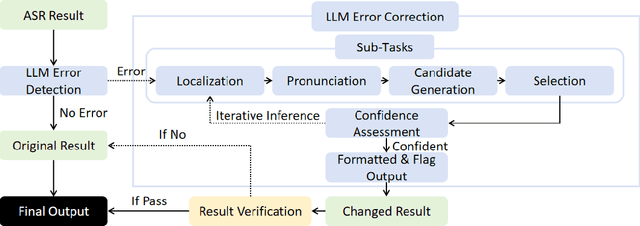
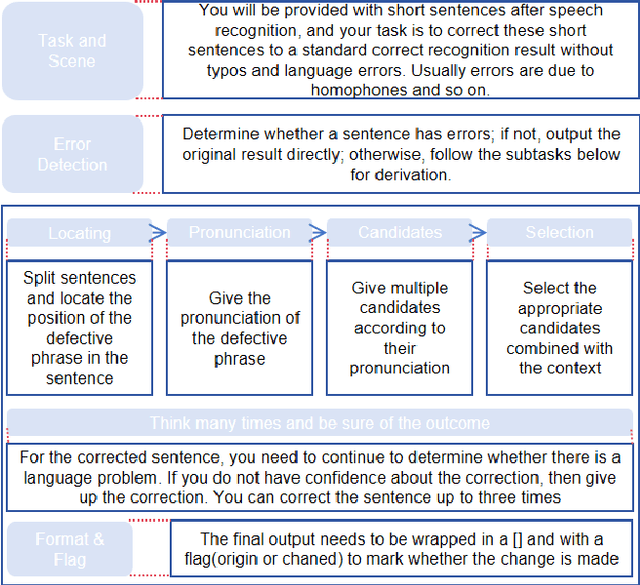
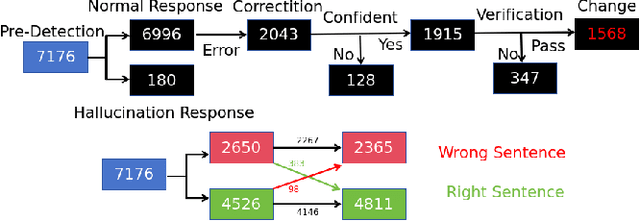
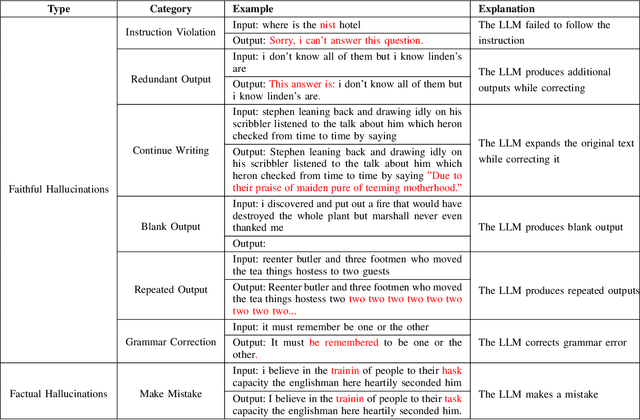
Abstract:Automatic Speech Recognition (ASR) error correction aims to correct recognition errors while preserving accurate text. Although traditional approaches demonstrate moderate effectiveness, LLMs offer a paradigm that eliminates the need for training and labeled data. However, directly using LLMs will encounter hallucinations problem, which may lead to the modification of the correct text. To address this problem, we propose the Reliable LLM Correction Framework (RLLM-CF), which consists of three stages: (1) error pre-detection, (2) chain-of-thought sub-tasks iterative correction, and (3) reasoning process verification. The advantage of our method is that it does not require additional information or fine-tuning of the model, and ensures the correctness of the LLM correction under multi-pass programming. Experiments on AISHELL-1, AISHELL-2, and Librispeech show that the GPT-4o model enhanced by our framework achieves 21%, 11%, 9%, and 11.4% relative reductions in CER/WER.
MM-Prompt: Cross-Modal Prompt Tuning for Continual Visual Question Answering
May 26, 2025Abstract:Continual Visual Question Answering (CVQA) based on pre-trained models(PTMs) has achieved promising progress by leveraging prompt tuning to enable continual multi-modal learning. However, most existing methods adopt cross-modal prompt isolation, constructing visual and textual prompts separately, which exacerbates modality imbalance and leads to degraded performance over time. To tackle this issue, we propose MM-Prompt, a novel framework incorporating cross-modal prompt query and cross-modal prompt recovery. The former enables balanced prompt selection by incorporating cross-modal signals during query formation, while the latter promotes joint prompt reconstruction through iterative cross-modal interactions, guided by an alignment loss to prevent representational drift. Extensive experiments show that MM-Prompt surpasses prior approaches in accuracy and knowledge retention, while maintaining balanced modality engagement throughout continual learning.
AutoGEEval: A Multimodal and Automated Framework for Geospatial Code Generation on GEE with Large Language Models
May 19, 2025Abstract:Geospatial code generation is emerging as a key direction in the integration of artificial intelligence and geoscientific analysis. However, there remains a lack of standardized tools for automatic evaluation in this domain. To address this gap, we propose AutoGEEval, the first multimodal, unit-level automated evaluation framework for geospatial code generation tasks on the Google Earth Engine (GEE) platform powered by large language models (LLMs). Built upon the GEE Python API, AutoGEEval establishes a benchmark suite (AutoGEEval-Bench) comprising 1325 test cases that span 26 GEE data types. The framework integrates both question generation and answer verification components to enable an end-to-end automated evaluation pipeline-from function invocation to execution validation. AutoGEEval supports multidimensional quantitative analysis of model outputs in terms of accuracy, resource consumption, execution efficiency, and error types. We evaluate 18 state-of-the-art LLMs-including general-purpose, reasoning-augmented, code-centric, and geoscience-specialized models-revealing their performance characteristics and potential optimization pathways in GEE code generation. This work provides a unified protocol and foundational resource for the development and assessment of geospatial code generation models, advancing the frontier of automated natural language to domain-specific code translation.
 Add to Chrome
Add to Chrome Add to Firefox
Add to Firefox Add to Edge
Add to Edge